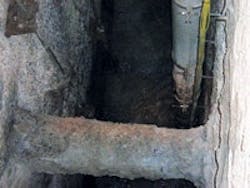About the author: Tony Oswald is Northeast sales manager for Sauereisen. Oswald can be reached at [email protected].
When an aging wet well in a Jersey City, N.J., pump station showed signs of deterioration, Richard Haytas, the licensed operator, and William Golden, Jr., chief of operations for the Jersey City Municipal Utilities Authority (JCMUA), took proactive steps to refurbish this critical component of its infrastructure.
“The wet well, originally constructed in 1949 and upgraded to a pumping station in 1987, serves approximately 160,000 Jersey City residents, processing a daily wastewater flow in excess of 20 million gal per day [mgd], with a capacity of 50 mgd,” Haytas said.
Decades of continued exposure to hydrogen sulfide gas and a heavy inflow of wastewater had deteriorated almost 5,000 sq ft of the concrete wall and ceiling surfaces, with corrosion in some spots as deep as 8 in., exposing the rebar throughout. In some areas, the first and second mats of rebar up to 1 in. in diameter had completely corroded away.
Rapid Concrete Repair
To determine the best installation plan and repair product system for its facility, the JCMUA consulted with Waterware Corp. of Philadelphia, a company with more than 25 years of experience restoring and resurfacing hundreds of wastewater chambers. Waterware specified Sauereisen’s system of fast-curing and durable substrate repair products and underlayments to enable a rapid concrete repair.
Due to the size and importance of the JCMUA Westside Pumping Station, minimizing its downtime during repair was critical to the project’s success. Waterware recommended that all of the repairs and installation be applied to the affected surfaces while the wet well was still in active service, with a temporary work platform using a scaffolding system, scissor lifts and a man cage to reach the affected areas with a substrate repair product that would be effective under those conditions.
“By choosing this construction method, we were able to save our client in excess of $500,000 in bypass pumping,” said Kevin Byrnes, head of the installation team for Waterware.
Dual-Product Protection
To restore the walls and ceiling of the 52-ft-long, 42-ft-deep, 5.5-ft-wide wet well, Waterware first used Sauereisen RestoKrete substrate resurfacer No. F-121, a Portland cement-based product suitable for wastewater applications. This pumpable product, which can be straight shot, rotary sprayed or troweled, provides ideal strength in restoring structural integrity. It is especially moisture tolerant, creating a water-resistant barrier for prevention of inflow and infiltration for use on concrete or brick in wastewater structures and manholes.
“In the JCMUA application, the substrate was sprayed onto the walls in minimum 1/2-in. layers to fill voids from 1/2 to 8 in. in depth,” said Kevin Grega, president of Corrosion Technology Systems Inc., who worked as part of the planning team. “Among its most important benefits is F-121’s quick cure rate, which can be top-coated after an initial set time of only eight hours at 70°F. Final set of F-121 is achieved in only 24 hours at 70°F.”
As the project progresses, Waterware will apply SewerGard Sprayable No. 210-S, a 100%-solids, fiber-filled, spray-applied epoxy polymer protective lining specifically formulated for wastewater environments, providing a chemical-resistant barrier for concrete and steel.
“This product is specified to protect wastewater infrastructure wherever corrosive conditions exist,” Grega said.
For a topcoat, SewerGard Glaze No. 210G, a 100%-solids epoxy polymer protective coating, will be installed. It can be used as an economical standalone coating or as an extra measure of protection. The product may be applied using plural component equipment, airless spray equipment, or brush and roller.
Final Step
This project is slated for completion by December 2012. Once the rebar and substrate repairs and epoxy coatings have been completed, the temporary work platform will be removed and the pump station will be returned to normal service. All of the work will have been completed without any disruption of service to the pump station.
“We’ve had many years of experience using Sauereisen’s products,” Byrnes said. “We have a successful track record with these products on similar projects in the Jersey City area, as well as throughout the region, many of which have now been in continued service for more than 20 years.”
Download: Here
